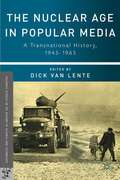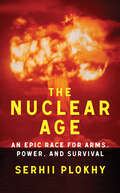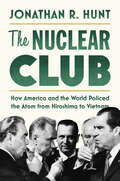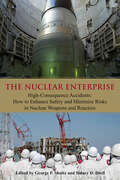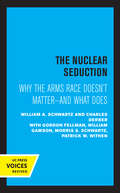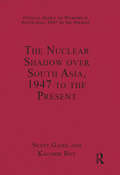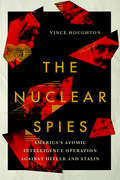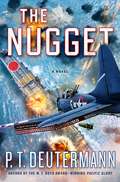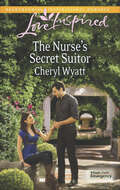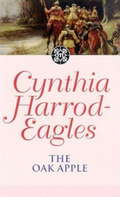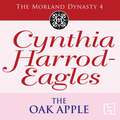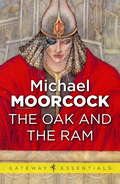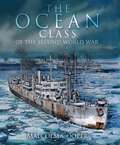- Table View
- List View
The Nuclear Age in Popular Media
by Dick Van LenteThe atomic age was described as one that might soon end in the destruction of human civilization, but from the beginning, utopian images were attached to it as well. This book compares representations of nuclear power in popular media from around the world to to trace divergences, convergences, and exchanges.
The Nuclear Age: An Epic Race for Arms, Power and Survival
by Serhii PlokhyA sweeping history of the geopolitics behind the nuclear arms race, from the first atomic bomb to today’s rush to stockpile nuclear weapons. The nuclear age came into existence with the explosion of the first atomic bomb in the New Mexico desert on July 16, 1945. The inauguration of this new era was epitomized by the bomb’s principal creator, J. Robert Oppenheimer, quoting the Bhagavad Gita: "Now I am become death, the destroyer of worlds." Since then, the era of the atom has become the age of the bomb?or two bombs: atomic and hydrogen. In The Nuclear Age, Serhii Plokhy, one of our preeminent Cold War historians, explores why governments have acquired and stockpiled nuclear weapons and reveals the global failure to reach meaningful nuclear arms treaties. Plokhy shows how, since the Cuban missile crisis of 1962, the risk of nuclear war has never been so high: Russia threatens nuclear aggression in its war on Ukraine; China is constructing hundreds of new missile silos; and India and Pakistan are locked in ongoing nuclear competition. Plokhy also examines how more countries than ever have come within perilous reach of acquiring nuclear arms, while new technologies, such as hypersonic missiles and artificial intelligence, make the nuclear landscape increasingly unpredictable. From Hiroshima, Nagasaki, and the Castle Bravo test of 1954, to the rapidly developing nuclear programs of North Korea and Iran, The Nuclear Age reveals the fear that governs the proliferation of nuclear weapons. Plokhy profiles the global players who have diagnosed, stoked, and influenced this fear, from H. G. Wells to Nikita Khrushchev and Vladimir Putin, and he outlines what we might learn from our past to control today’s arms race. As the danger of nuclear war remains imminent, The Nuclear Age diagnoses our era of rearmament.
The Nuclear Club: How America and the World Policed the Atom from Hiroshima to Vietnam
by Jonathan R. HuntThe Nuclear Club reveals how a coalition of powerful and developing states embraced global governance in hopes of a bright and peaceful tomorrow. While fears of nuclear war were ever-present, it was the perceived threat to their preeminence that drove Washington, Moscow, and London to throw their weight behind the 1963 Limited Test Ban Treaty (LTBT) banishing nuclear testing underground, the 1967 Treaty of Tlatelolco banning atomic armaments from Latin America, and the 1968 Nuclear Non-Proliferation Treaty (NPT) forbidding more countries from joining the most exclusive club on Earth. International society, the Cold War, and the imperial U.S. presidency were reformed from 1945 to 1970, when a global nuclear order was inaugurated, averting conflict in the industrial North and yielding what George Orwell styled a "peace that is no peace" everywhere else. Today the nuclear order legitimizes foreign intervention worldwide, empowering the nuclear club and, above all, the United States, to push sanctions and even preventive war against atomic outlaws, all in humanity's name.
The Nuclear Crisis: The Arms Race, Cold War Anxiety, and the German Peace Movement of the 1980s (Protest, Culture & Society #19)
by Martin Klimke Philipp Gassert Wilfried Mausbach Christoph Becker-SchaumIn 1983, more than one million Germans joined together to protest NATO's deployment of nuclear missiles in Europe. International media overflowed with images of marches, rallies, and human chains as protesters blockaded depots and agitated for disarmament. Though they failed to halt the deployment, the episode was a decisive one for German society, revealing deep divisions in the nation's political culture while continuing to mobilize activists. This volume provides a comprehensive reference work on the "Euromissiles" crisis as experienced by its various protagonists, analyzing NATO's diplomatic and military maneuvering and tracing the political, cultural, and moral discourses that surrounded the missiles' deployment in East and West Germany.
The Nuclear Enterprise: High-Consequence Accidents: How to Enhance Safety and Minimize Risks in Nuclear Weapons and Reactors
by George P. Shultz Sidney D. DrellA panel of expert contributors offers its views on the risks and rewards of the nuclear enterprise, focusing on issues of safety, regulation, and public perception. Contributors discuss specific experience and issues regarding the technical safety of weapons and power plants, management operations, regulatory measures, and the importance of accurate communication by the media.
The Nuclear Non-proliferation Treaty
by Ian Bellany Coit D. Blacker Joseph GallacherThis study looks at the interpretations and effects of the Nuclear Non-Proliferation Treaty and offers readings of its possible future effects.
The Nuclear Seduction: Why the Arms Race Doesn't Matter--And What Does
by Charles Derber William A. SchwartzThis title is part of UC Press's Voices Revived program, which commemorates University of California Press’s mission to seek out and cultivate the brightest minds and give them voice, reach, and impact. Drawing on a backlist dating to 1893, Voices Revived makes high-quality, peer-reviewed scholarship accessible once again using print-on-demand technology. This title was originally published in 1990.
The Nuclear Shadow over South Asia, 1947 to the Present (Critical Essays on Warfare in South Asia, 1947 to the Present)
by Kaushik RoyThis collection of seminal articles illustrates the reasons for the spiraling nuclear race in the Asian subcontinent and introduces the principal debates in the field. Authors discuss whether the acquisition of nuclear weapons by the South Asian powers has raised the likelihood of a nuclear war in the subcontinent or reduced the chance of a conventional war breaking out. They examine whether a small nuclear arsenal or a nuclear triad, as declared by India, is suitable for bringing stability to the region, as well as the risk of an accidental nuclear conflagration. The first section charts the evolution of nuclear programmes on the basis of realpolitik, and the second section analyses nuclear policies on the basis of religious and cultural ethos. A few essays turn the spotlight on the role of external powers in accelerating, decelerating and mediating the ongoing nuclear tension between India and Pakistan.
The Nuclear Sphinx of Tehran: Mahmoud Ahmadinejad and the State of Iran
by Yossi Melman Meir JavedanfarAs President, Mahmoud Ahmadinejad has accelerated his country’s nuclear research; called for the elimination of Israel; and failed the Iranian people, who elected him on a domestic platform that has since been neglected. This probing exposé gives unprecedented insight into his hold on power-his rural roots, the vituperative populism that catapulted him from relative obscurity to national leadership, and the shadowy forces that hold him there.
The Nuclear Spies: America's Atomic Intelligence Operation against Hitler and Stalin
by Vince HoughtonWhy did the US intelligence services fail so spectacularly to know about the Soviet Union's nuclear capabilities following World War II? As Vince Houghton, historian and curator of the International Spy Museum in Washington, DC, shows us, that disastrous failure came just a few years after the Manhattan Project's intelligence team had penetrated the Third Reich and knew every detail of the Nazi 's plan for an atomic bomb. What changed and what went wrong?Houghton's delightful retelling of this fascinating case of American spy ineffectiveness in the then new field of scientific intelligence provides us with a new look at the early years of the Cold War. During that time, scientific intelligence quickly grew to become a significant portion of the CIA budget as it struggled to contend with the incredible advance in weapons and other scientific discoveries immediately after World War II. As Houghton shows, the abilities of the Soviet Union's scientists, its research facilities and laboratories, and its educational system became a key consideration for the CIA in assessing the threat level of its most potent foe. Sadly, for the CIA scientific intelligence was extremely difficult to do well. For when the Soviet Union detonated its first atomic bomb in 1949, no one in the American intelligence services saw it coming.
The Nugget: A Novel (P. T. Deutermann WWII Novels)
by P. T. DeutermannA novice naval aviator grows into a hero in this gripping and authentic World War II adventure by master storyteller P. T. Deutermann Lieutenant Bobby Steele, USN, is a fresh-faced and eager naval aviator: a "Nugget," who needs to learn the ropes and complex procedures of taking off and returning safely to his aircraft carrier. A blurry night of drinking lands him in an unfamiliar bed aboard the USS Oklahoma; later that day, the Japanese destroy Pearl Harbor. After cheating death and losing his friend in this act of war, the formerly naive Steele vows to avenge the attack.Flying sea battle after battle, Steele survives the most dangerous air combat in World War II, including Midway, is shot down twice, rescued twice, and eventually leads a daring mission to free prisoners from a secluded Japanese POW camp. Packed with authentic military action on land and at sea in the Pacific Theatre of WWII and featuring a memorable protagonist based on a true-life hero, The Nugget is a first-class adventure by a former commander whose family served in the Pacific.
The Nuremberg Raid: 30-31 March 1944
by Martin MiddlebrookA thorough history of the RAF Bomber Command attack on the German city during World War II, by the author of The First Day on the Somme. This book describes one twenty-four-hour period in the Allied Strategic Bomber Offensive in the greatest possible detail. Author Martin Middlebrook sets the scene by outlining the course of the bombing war from 1939 to the night of the Nuremberg raid, the characters and aims of the British bombing leaders, and the composition of the opposing Bomber Command and German night fighter forces. The aim of the Nuremberg raid was not unlike many hundreds of other Royal Air Force missions but, due to the difficulties and dangers of the enemy defenses and weather plus bad luck, it went horribly wrong. The result was so notorious that it became a turning point in the campaign. The target, the symbolic Nazi rally city of Nuremberg, was only lightly damaged, and 96 out of 779 bombers went missing. Middlebrook recreates the events of the fateful night in astonishing detail. The result is a meticulous, dramatic, and often controversial account. It is also a moving tribute to the bravery of the RAF bomber crews and their adversaries.Praise for The Nuremberg Raid&“Employing hundreds of eyewitness accounts, he shows the raid from the point of view of the German defenses and the civilians on the ground. Factual and analytical, this is a portrait of mechanized warfare at the level of personal experience.&” —Simon Mawer, Wall Street Journal
The Nuremberg War Crimes Trial, 1945-46
by Michael R. MarrusBetween November 1945 and October 1946, 22 high-ranking Nazi officials defended themselves before the International Military Tribunal. Reproducing significant sections of the trial record, this volume also outlines the background to the trial, traces the preparations made by the principle actors in the courtroom, and considers how the prosecution, defense, and tribunal dealt with the counts against the accused.
The Nurse's Bodyguard
by Melanie MitchellA nurse far from home encounters a danger she can’t understand and a military man willing to risk his life—and heart—for her . . .Claire Olsen has been in Seoul, South Korea, for only one month. She doesn’t know anyone—aside from her roommate and her colleagues at the medical center—and she certainly doesn’t know why someone would attack her. Desperate to forget about the violent mugging, Claire tries to focus on her nursing, but one man won’t let her hide from the truth.Naval intelligence officer Luke Llewellyn is determined to keep Claire safe, whether she wants him to or not. But finding out why she’s been targeted means helping Claire unearth the secrets of her past. And following his heart means trusting Claire with his own secrets . . .
The Nurse's Secret Suitor (Eagle Point Emergency #3)
by Cheryl WyattA Strong-Willed Heart Trauma nurse Kate Dalton can handle any challenge-except love. The combat veteran dreams of settling down, but heartbreak is one risk she won't take. Then a chance encounter opens her heart to a masked stranger...who might not be a stranger after all! Caleb Landis, the army medic behind the disguise, has always admired Kate, even though she only saw him as her best friend's brother. What will it take for Kate to discard her fears and discover the man she's always hoped to unmask? Eagle Point Emergency: Saving lives-and losing their hearts- in a small Illinois town
The Oak Apple: The Morland Dynasty, Book 4 (Morland Dynasty #4)
by Cynthia Harrod-Eagles1630: after long years of peace the reign of Charles I brings brutal civil war to England.The clash between King and Parliament is echoed at Morland Place when Richard brings home a Puritan bride while his brother, Kit, joins Prince Rupert and the Royalist cavalry, leaving their father Edmund desperately trying to steer a middle course between the fighting factions.As the war grinds on, bitterness and disillusion replace the early fervour, and the schisms between husband and wife, father and son, grow deeper. Edmund struggles grimly through it all in an attempt to keep the Morland fortune intact, but he is thwarted by the estrangement between his sons and then alienated from his beloved wife, Mary.
The Oak Apple: The Morland Dynasty, Book 4 (Morland Dynasty #4)
by Cynthia Harrod-Eagles1630: after long years of peace the reign of Charles I brings brutal civil war to England.The clash between King and Parliament is echoed at Morland Place when Richard brings home a Puritan bride while his brother, Kit, joins Prince Rupert and the Royalist cavalry, leaving their father Edmund desperately trying to steer a middle course between the fighting factions.As the war grinds on, bitterness and disillusion replace the early fervour, and the schisms between husband and wife, father and son, grow deeper. Edmund struggles grimly through it all in an attempt to keep the Morland fortune intact, but he is thwarted by the estrangement between his sons and then alienated from his beloved wife, Mary.
The Oak and the Ram (Gateway Essentials #448)
by Michael MoorcockThe seasons have turned from spring to summer across the quiet earth - yet the Fhoi Myore were hiding in mist, awaiting their chance to unleash their icy realm of death. To defeat the Cold Gods, Corum of the Silver Hand must restore the High King's power with legendary treasures - the Golden Oak and the Silver Ram - lost talismans that wield miraculous forces. Forces that Corum must now tame...
The Oakdale Affair
by Edgar Rice BurroughsThe beautiful young daughter of a wealthy family is robbed of her money and jewels, and she herself disappears soon after... A young man fleeing a band of murderous hobos becomes the target of a lynch mob... Frozen to silent rigidity, they sat straining every faculty to catch the minutest sound from the black void where the dead man lay. As they listened there came up to them, mingled with inexplicable footsteps, a hollow reverberation from the dank cellar - a hideous dragging of chains behind the nameless horror which had haunted them through the interminable eons of the ghastly night. Up, up it came toward the room at the head of the stairs where they huddled fearfully. They could now hear quite clearly what might have been the slow and ponderous footsteps of a heavy man dragging painfully across the rough floor. It stopped in front of their hideout and all was silent. Suddenly their rang out against the silence of the awful night a piercing shriek, and a great The Oakdale Affair force began to bend the flimsy door...
The Oaken Heart: The Story of an English Village at War
by Margery AllinghamWorld War II on the home front: &“Fans of The Guernsey Literary and Potato Peel Pie Society or James Herriot will enjoy this unique historical account.&” —Library Journal This remarkable firsthand account—from the acclaimed Golden Age mystery author—was written to let people know how the Second World War affected ordinary English country people. The Oaken Heart is Margery Allingham&’s tribute to the resiliency and determination of the people of Tolleshunt D&’Arcy, the Essex village where she lived and nicknamed &“Auburn&” in her manuscript. Allingham, already a successful mystery author in 1939, was at work on the Albert Campion novel Traitor&’s Purse. The first hint of war was felt in the alarm of a radio announcer&’s voice, and Allingham put down her pen as her peaceful corner of the world braced for sending its men into battle, and even possible invasion. As villagers rallied around the cause—supporting each other and their country—Allingham found herself acting as the local billeting officer and first aid organizer. She writes of the sacrifices of farmers, the mistrust of politics, the grim acceptance of rationing, the bombing of London. And through it all, the never-ending hope for peace. The Oaken Heart captures the personal and universal toll of war, far from the front lines, written by a woman whose own quest for justice jumped from the page to the streets where she lived. &“Engrossing and moving.&” —Kirkus Reviews &“Her record of the events and people of this fraught wartime period is rendered with the skill found in the best of her fictional writing . . . remains an insight into another facet of a remarkable talent.&” —Crime Time
The Obsidian Temple: A Desert Rising Novel (Desert Rising Novels #2)
by Kelley GrantIn this mesmerizing sequel to the epic fantasy Desert Rising, Kelley Grant brings us back to the cities of Illian and Shpeth, where the fate of the world hangs in the balance, and two twins--Sulis and Kadar--might have enough magic and power to finally bring about peace.After a harrowing escape to the desert, Sulis Hasifel finds her calling is not yet fulfilled. Traveling to the Obsidian Temple—the site of an ancient divine battle—Sulis is tasked with mentoring Ava, a young girl with a troubled past. Together, they join a group of magically gifted warriors to re-make the very fabric of the universe. But the fate of the world hinges on whether Ava can harness her power, and some trials cannot be overcome.Returning to Illian, Sulis's twin Kadar finds that his lover, Farrah, has abandoned their newborn daughter for the revolutionary cause. Not willing to give up his dream of a family, Kadar vows to stay by Farrah's side. But when he finds that Farrah is willing to anger the gods to aid the Forsaken caste's uprising, and as she steps farther down a violent and dark path, Kadar must decide if he will help her…or let the world spin out of control.
The Occupation Secret
by Mario ReadingA German commander and a French farmgirl find forbidden love during World War II in this powerful, posthumous historical saga. Relegated to an isolated provincial town in France after years spent fighting on the Eastern Front, German commander Maximilian von Aschau finds unexpected distraction in the form of beautiful and reserved Lucie Léré. He&’s seen every horror of the human experience. She&’s never left her village. Opposites in every way, Max and Lucie manage to find common ground. But love is the most dangerous element of war. It makes you vulnerable . . . and careless. With the Allied invasion imminent and tensions high, Max and Lucie will have to turn their backs on everything they&’ve known and anyone they once trusted to protect their secret—and their lives. A poignant, spellbinding historical novel of love and war that will appeal to fans of Anthony Doerr and Heather Morris.
The Occupation of Havana: War, Trade, and Slavery in the Atlantic World (Published by the Omohundro Institute of Early American History and Culture and the University of North Carolina Press)
by Elena A. SchneiderIn 1762, British forces mobilized more than 230 ships and 26,000 soldiers, sailors, and enslaved Africans to attack Havana, one of the wealthiest and most populous ports in the Americas. They met fierce resistance. Spanish soldiers and local militias in Cuba, along with enslaved Africans who were promised freedom, held off the enemy for six suspenseful weeks. In the end, the British prevailed, but more lives were lost in the invasion and subsequent eleven-month British occupation of Havana than during the entire Seven Years' War in North America.The Occupation of Havana offers a nuanced and poignantly human account of the British capture and Spanish recovery of this coveted Caribbean city. The book explores both the interconnected histories of the British and Spanish empires and the crucial role played by free people of color and the enslaved in the creation and defense of Havana. Tragically, these men and women would watch their promise of freedom and greater rights vanish in the face of massive slave importation and increased sugar production upon Cuba's return to Spanish rule. By linking imperial negotiations with events in Cuba and their consequences, Elena Schneider sheds new light on the relationship between slavery and empire at the dawn of the Age of Revolutions.
The Ocean Between Us (Mills and Boon Ser.)
by Susan WiggsDeception, distance, and disaster test a weary military marriage in this classic novel of love and family by a #1 New York Times–bestselling author.After years of following her navy officer husband on assignment around the world, Grace Bennett realizes that she’s left something behind—herself. Her husband, Steve, can’t understand the unraveling of his wife’s heart and is determined to set things right. Their already-strained relationship is pushed to the edge when old secrets are revealed.Now, with plenty of space to ponder the true distance between them, Grace begins to reinvent herself. But, just as her new self is coming to terms with her family life, the unthinkable happens: a disaster aboard Steve’s ship. A navy wife’s worst nightmare collides with the cold truth that life’s biggest chances can slip away while you’re busy looking for guarantees.Originally published in 2004.“A human and multilayered story exploring duty to both country and family.” —Nora Roberts“Wiggs’s light, engaging style keeps the story moving. . . . Her characters are sympathetic and her tale of frayed loves mended is sure to strike a responsive chord.” —Publishers Weekly
The Ocean Class of the Second World War
by Malcolm CooperThis new book tells the story of the Ocean class of standard cargo ships, their design, building, and careers, and the author places them firmly in the context of the battle of the Atlantic which was raging at the time of the first launchings. They entered the vanguard of the Allied shipping effort at a time when the German U-boat threat was at its most dangerous, and British shipping resources were stretched to the limit. They were deployed in the North Atlantic, on the long supply routes around Africa to the Middle East, in the Russian convoys, in operations in support of the invasions of North Africa and Italy and the land campaigns which followed, in the D-Day landings, and later amphibious operations on the south coast of France. Finally, some of the class joined an invasion force making its way towards Malaya when Japan surrendered in August 1945. The Oceans paid a heavy price for these accomplishments, one third of the class being lost to torpedoes, bombs, or mines in places as far apart as the Florida coast, the Norwegian Sea, the Bay of Algiers, and the Gulf of Oman. While these achievements alone would merit an important place in histories of the war at sea, the impact of the Oceans stretched far beyond the direct contribution of the ships themselves. The yards where they were built also served as models for a series of new American shipyards, designed to mass produce cargo vessels with such speed and in such volume as to completely reverse the mathematics of attrition, which had run so badly against the Allies into 1942. Even more important, the Oceans’ blueprints were used as the basis for the American Liberty ship, the 2,700-strong fleet which finally tilted the balance of the war at sea decisively in the Allies’ favor and went on to underpin the post-war renewal of the world merchant fleet. This comprehensive new history, based on extensive archival research and lavishly illustrated with contemporary photographs, restores the Oceans to their rightful place in history. The ships’ design antecedents are explained, and their ordering, financing, and construction analyzed in full. Wartime operations are covered in depth, by theater, and with full details of war losses and other casualties. The book concludes with an assessment of their subsequent peacetime careers and a comparison to other war-built designs. This is a model history of a highly significant class of ship.
